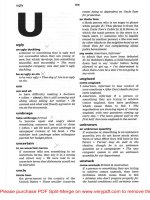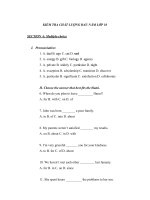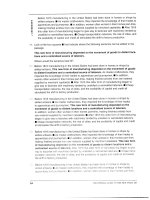Symbols of addition 10 pdf
Bạn đang xem bản rút gọn của tài liệu. Xem và tải ngay bản đầy đủ của tài liệu tại đây (91.81 KB, 6 trang )
Examples
x = 5 Contains no variable y, so you cannot isolate y. This is not a function.
2x + 3y = 5 Isolate y:
2x + 3y =5
–2x –2x
ᎏ
3
3
y
ᎏ
=
ᎏ
–2x
3
+5
ᎏ
y =–
ᎏ
3
2
x
ᎏ
+
ᎏ
5
3
ᎏ
This is a linear function, of the form y = mx + b.
x
2
+ y
2
= 36 Contains y
2
, so it is not a function.
|y| = 5 There is no way to isolate y with a single equation, therefore it is not a function.
FUNCTION
NOTATION
Instead of using the variable y, often you will see the variable f(x). This is shorthand for “function of x” to auto-
matically indicate that an equation is a function. This can be confusing; f(x) does not indicate two variables f and
x multiplied together, it is a notation that means the single variable y.
Although it may seem that f(x) is not an efficient shorthand (it has more characters than y), it is very elo-
quent way to indicate that you are being given expressions to evaluate. For example, if you are given the equation
f(x) = 5x – 2, and you are being asked to determine the value of the equation at x = 2, you need to write “evalu-
ate the equation f(x) = 5x – 2 when x = 2.” This is very wordy. With function notation, you only need to write
“determine f(2).” The x in f(x) is replaced with a 2, indicating that the value of x is 2. This means that f(2) = 5(2)
– 2 = 10 – 2 = 8.
All you need to do when given an equation f(x) and told to evaluate f(value), replace the value for every occur-
rence of x in the equation.
Example
Given the equation f(x) = 2x
2
+ 3x + 1, determine f(0) and f(–1).
f(0) means replace the value 0 for every occurrence of x in the equation and evaluate.
f(0) = 2(0)
2
+ 3(0) + 1
= 0 + 0 + 1
=1
f(–1) means replace the value –1 for every occurrence of x in the equation and evaluate.
f(0) = 2(–1)
2
+ 3(–1) + 1
= 2(1) + –3 + 1
= 2 – 3 + 1
=0
– THEA MATH REVIEW–
135
FAMILIES OF
FUNCTIONS
There are a number of different types, or families, of functions. Each function family has a certain equation and
its graph takes on a certain appearance. You can tell what type of function an equation is by just looking at the
equation or its graph.
These are the shapes that various functions have. They can appear thinner or wider, higher or lower, or upside
down.
Systems of Equations
A system of equations is a set of two or more equations with the same solution. Two methods for solving a sys-
tem of equations are substitution and elimination.
SUBSTITUTION
Substitution involves solving for one variable in terms of another and then substituting that expression into the
second equation.
Linear Function
f(x) = mx + b
y = mx + b
Constant Function
f(x) = c
y = c
The equation contains no
variable x.
Quadratic Function
f(x) = ax
2
+ bx + c
y = ax
2
+ bx + c
This is the function name
for a parabola.
Square Root Function
The equation has to
contain a square root
symbol.
Cubic Function
f(x) = ax
3
+ bx
2
+ cx + d
y = ax
3
+ bx
2
+ cx + d
Absolute Value Function
The equation has to have
an absolute value symbol
in it.
– THEA MATH REVIEW–
136
Example
2p + q = 11 and p + 2q = 13
■
First, choose an equation and rewrite it, isolating one variable in terms of the other. It does not matter
which variable you choose.
2p + q = 11 becomes q = 11 – 2p.
■
Second, substitute 11 – 2p for q in the other equation and solve:
p + 2(11 – 2p) = 13
p + 22 – 4p = 13
22 – 3p = 13
22 = 13 + 3p
9 = 3p
p = 3
■
Now substitute this answer into either original equation for p to find q.
2p + q = 11
2(3) + q = 11
6 + q = 11
q = 5
■
Thus, p = 3 and q = 5.
ELIMINATION
The elimination method involves writing one equation over another and then adding or subtracting the like terms
on the same sides of the equal sign so that one letter is eliminated.
Example
x – 9 = 2y and x – 3 = 5y
■
Rewrite each equation in the same form.
x – 9 = 2y becomes x – 2y = 9 and x – 3 = 5y becomes x – 5y = 3.
■
If you subtract the two equations, the x terms will be eliminated, leaving only one variable:
Subtract:
x – 2y = 9
–(x – 5y = 3)
ᎏ
3
3
y
ᎏ
=
ᎏ
6
3
ᎏ
y = 2 is the answer.
– THEA MATH REVIEW–
137
■
Substitute 2 for y in one of the original equations and solve for x.
x – 9 = 2y
x – 9 = 2(2)
x – 9 = 4
x – 9 + 9 = 4 + 9
x = 13
■
The answer to the system of equations is y = 2 and x = 13.
If the variables do not have the same or opposite coefficients as in the example above, adding or subtract-
ing will not eliminate a variable. In this situation, it is first necessary to multiply one or both of the equations by
some constant or constants so that the coefficients of one of the variables are the same or opposite. There are many
different ways you can choose to do this.
Example
3x + y = 13
x + 6y = –7
We need to multiply one or both of the equations by some constant that will give equal or opposite coeffi-
cients of one of the variable. One way to do this is to multiply every term in the second equation by –3.
3x + y = 13
–3(x + 6y = –7) → –3x – 18y = 21
Now if you add the two equations, the “x” terms will be eliminated, leaving only one variable. Continue as
in the example above.
3x + y =13
–3x – 18y =21
ᎏ
–
–
1
1
7
7
y
ᎏ
=
ᎏ
–
3
1
4
7
ᎏ
y = –2 is the answer.
■
Substitute –2 for y in one of the original equations and solve for x.
3x + y =13
3x + (–2) = 13
3x + (–2) + –2 = 13 + –2
3x =11
x =
ᎏ
1
3
1
ᎏ
■
The answer to the system of equations is y = –2 and x =
ᎏ
1
3
1
ᎏ
.
– THEA MATH REVIEW–
138
Inequalities
Linear inequalities are solved in much the same way as simple equations. The most important difference is that
when an inequality is multiplied or divided by a negative number, the inequality symbol changes direction.
Example
10 > 5 so (10)(–3) < (5)(–3)
–30 < –15
SOLVING
LINEAR INEQUALITIES
To solve a linear inequality, isolate the letter and solve the same way as you would in a linear equation. Remem-
ber to reverse the direction of the inequality sign if you divide or multiply both sides of the equation by a nega-
tive number.
Example
If 7 – 2x > 21, find x.
■
Isolate the variable.
7 – 2x > 21
–7 –7
–2x > 14
■
Because you are dividing by a negative number, the direction of the inequality symbol changes direction.
ᎏ
–
–
2
2
x
ᎏ
>
ᎏ
–
14
2
ᎏ
x < –7
■
The answer consists of all real numbers less than –7.
SOLVING COMPOUND INEQUALITIES
To solve an inequality that has the form c < ax + b < d, isolate the letter by performing the same operation on each
part of the equation.
Example
If –10 < –5y – 5 < 15, find y.
■
Add five to each member of the inequality.
–10 + 5 < –5y – 5 + 5 < 15 + 5 – 5 < –5y < 20
■
Divide each term by –5, changing the direction of both inequality symbols:
ᎏ
–
–
5
5
ᎏ
< –
ᎏ
–
5
5
y
ᎏ
<
ᎏ
–
20
5
ᎏ
= 1 > y > –4
The solution consists of all real numbers less than 1 and greater than –4.
– THEA MATH REVIEW–
139
Geometry
This section will familiarize you with the properties of angles, lines, polygons, triangles, and circles, as well as the
formulas for area, volume, and perimeter.
Geometry is the study of shapes and the relationships among them. Basic concepts in geometry will be
detailed and applied in this section. The study of geometry always begins with a look at basic vocabulary and con-
cepts. Therefore, a list of definitions and important formulas is provided below.
Geometry Terms
Area the space inside a 2-dimensional figure
Circumference the distance around a circle
Chord a line segment that goes through a circle, with its endpoints on the circle
Congruent lengths, measures of angles, or size of figures are equal
Diameter a chord that goes directly through the center of a circle—the longest line segment that
can be drawn in a circle
Hypotenuse the longest side of a right triangle, always opposite the right angle
Leg either of the two sides of a right triangle that make the right angle
Perimeter the distance around a figure
π (pi) The ratio of any circle’s circumference to its diameter. Pi is an irrational number, but
most of the time it is okay to approximate π with 3.14.
Radius a line segment from the center of a circle to a point on the circle (half of the diameter)
Surface Area the sum of the areas of all of a 3-dimensional figure’s faces
Vol u m e the space inside a 3-dimensional figure
– THEA MATH REVIEW–
140









